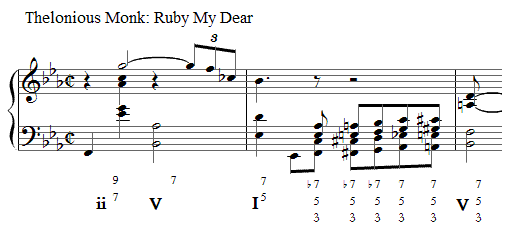APPENDIX A: VOICE LEADING OVERVIEW
Parallel 7ths in Jazz
In the section on the blues 7th, we saw that the rules of voice leading were relaxed to allow parallel minor 7ths in the 12 bar blues progression. In jazz, in its many forms, many changes are made in the use of chords (chord syntax), the use of scales and in voice leading, too many to fully explore here, but a common change that is made in the voice leading rules is sufficiently important that it is worth including here. That is, the relaxation in the use of parallel 7ths is taken even further than in the blues. The major 7th is used as a consonance and the major 7th in addition to the minor 7th is used in parallel movement. In fact, step by step consecutive 7ths can be used as a kind of linear progression. For instance, in the following example from Thelonious Monk's Solo Ruby My Dear (transcribed by Bob Himmelberger, Embassy Music Corporation) The progression from chord I to the second chord V is filled in with a chromatic linear progression in the bass but rather than following the normal rules about linear progressions whereby the moving parts move in parallel 3rds, 6ths or 10ths, here the parallel movement is simultaneously in 5ths and 7ths and 10ths. All the 5ths are perfect and the sevenths start off as minor 7ths but then change to major 7ths. Similar linear parallel movement is frequently used in jazz. Again, this is a voice leading device that elaborates on the underlying chord progression which is chord I to chord V.

In this example, I've shown the structural chords by roman numerals. The figured bass numbers (as always) show the intervals from the bass (not the root of a chord, which is sometimes the case). They highlight the voice leading movement. As the bass moves step by step from the tonic Eb to the dominant Bb, the parts above move in parallel compound 3rds, 5ths and 7ths. For clarity, I've shown minor 7ths as b7 and major 7ths as just 7. Note that, in figured bass notation, it is normal to show compound intervals (such as 10ths) as their non-compound equivalents for simplicity. This is the convention I'll normally follow unless I want to highlight the use of compound intervals for some reason.
This is an illustration of how we can understand a device that goes beyond normal tonal chord syntax and voice leading rules, within the same overall analytical method. This makes the method sensitive to period and stylistic factors.
It is not the purpose of this appendix to cover all possible stylistic changes, particularly in 20th century music. However, this appendix shows how analysis of music which is outside of the "common practice" tonal period can be carried out in a way that is sensitive to the style of the music, by taking account of developments in chord, voice leading and root progression syntax.

